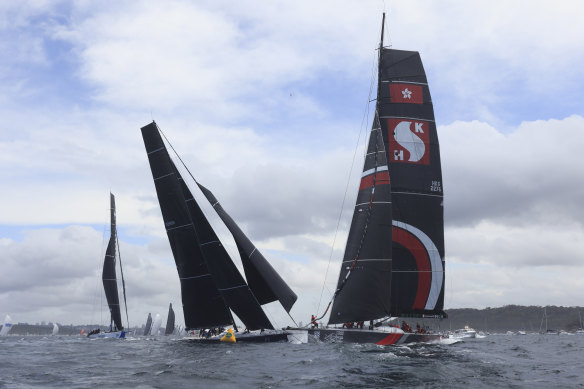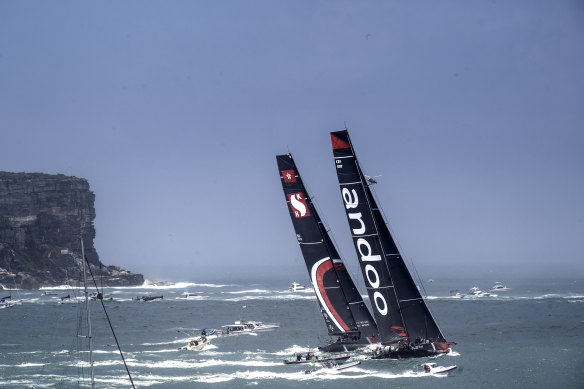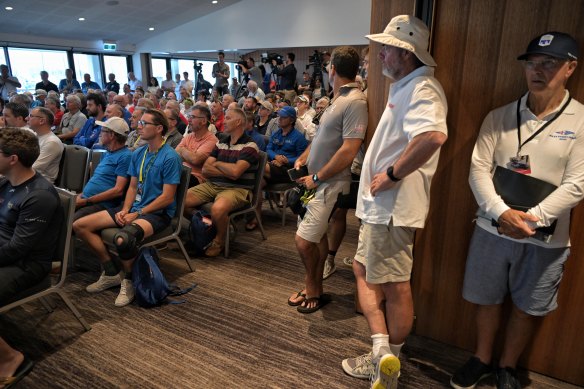- Updated
- Sport
- Sailing
- Sydney to Hobart
This was published 10 months ago
Big gun Scallywag retires from Sydney to Hobart with stormy weather ahead
By Emma Kemp
Sydney to Hobart line honours contender SHK Scallywag has retired from the yacht race with a broken bow sprit.
The Hong Kong-based 100-foot supermaxi had been flying down the NSW south coast in third position behind Andoo Comanche and LawConnect when the damage forced her to withdraw off Gerroa on Tuesday evening.
She was about six hours into the race and seeking to make up lost ground after completing a 720-degree penalty turn after a dramatic almost-collision with reigning line honours winner Andoo Comanche, who protested after she tacked very close.
It was to be the 27th and last chance at a maiden win for skipper David Witt, a veteran of other yachts including Ragamuffin, after pre-race news Scallywag would not contest the bluewater classic again.
She had spent the past 18 months out of the water undergoing modifications in readiness for the tilt, including losing 500 kilograms in weight off her mast.
“The team are obviously very disappointed given the great progress we were making but thankful no one was injured and that we could safely recover the sails that were in the air at the time,” a statement from SHK Scallywag read. “The team are currently making their way back to Sydney.”

Scallywag (right) is out of the Sydney to Hobart Yacht Race.Credit: Getty
LawConnect was the first Sydney to Hobart yacht out of the harbour but faces stiff competition from the other supermaxis – and potential thunderstorms.
The 100-footer and perennial line honours runner-up took advantage of a near-collision between defending winner Andoo Comanche and Scallywag to cross the Sydney Heads threshold ahead of the other 102 contenders.
But after three and a half hours of racing, Andoo Comanche seized the lead off the coast of Port Kembla, and settled in just ahead of LawConnect and Scallywag. Andoo Comanche was still leading at 8.30pm (AEDT).
The fourth supermaxi, Wild Thing 100, was leading a second pack also featuring overall contenders Moneypenny, Whisper and reigning champion Celestial.

Scallywag and Andoo Comanche came close to colliding soon after the start of the Sydney to Hobart.Credit: Louise Kennerley
What happens overnight on Tuesday is anyone’s guess, with forecasts of storms which could bring rain, sudden and erratic wind changes and even hail over the coming days as the fleet ventures towards the notoriously volatile Bass Strait.
For the opening few hours, though, wind was at a premium, and crews ventured well east of the NSW coast in the search of something to get them going.
That Scallywag was still in hot pursuit at that point was something in itself, after she completed a 720-degree penalty turn – or two full turns – off the coast of Bondi to absolve herself of a possible time sanction.
In a dramatic turn of events, Andoo Comanche waved the protest flag against Scallywag for allegedly tacking too close after very nearly coming into contact just minutes after the start.
The hold-up helped LawConnect, who had been forced to complete a turn herself after a furling line snapped. The issue has since been fixed.
Many of the big yachts had issues changing their sails in the strange conditions.
Lightning flashed and thunder cracked over the city skyline about 12.20pm, as dark clouds descended over the harbour. And five minutes later, the rain had well and truly started falling near Sydney’s heads.
But by the time the cannon sounded at 1pm to signal the start of the bluewater classic, the boats were tacking under clear skies.

It was standing room only at Tuesday’s pre-race weather briefing.Credit: Nick Moir
Wild weather is nothing new for the 628-nautical-mile trip to Constitution Dock, but this year’s predictions have been unusually variable in the days leading up to the start.
When the Bureau of Meteorology delivered the fleet their final race briefing on Tuesday morning, it warned of wild weather, and the docks at the Cruising Yacht Club of Australia cleared out early as apprehensive sailors got themselves ready to deal with whatever Mother Nature threw their way.
Iain Murray, the sailing master of Andoo Comanche, said the conditions would pose unique challenges for the four 100-foot supermaxis.
“We don’t like thunderstorms,” he said. “We get wet but it’s also very volatile for the wind.
“These big 100-footers, you have big sails and little sails and changing them is quite a process so you have to be well ahead of the curve and plan for it.
“It’s not like a little boat where it’s just ‘bang’, change the sails. It’s a half-hour mission to rig the boat for whatever you get. These volatile conditions are really testing for the big boats.”
Sports news, results and expert commentary. Sign up for our Sport newsletter.